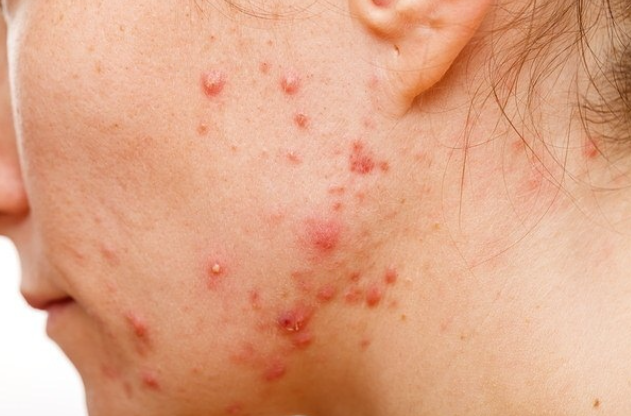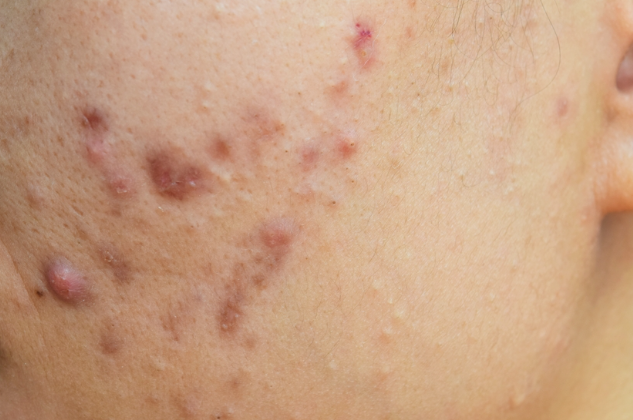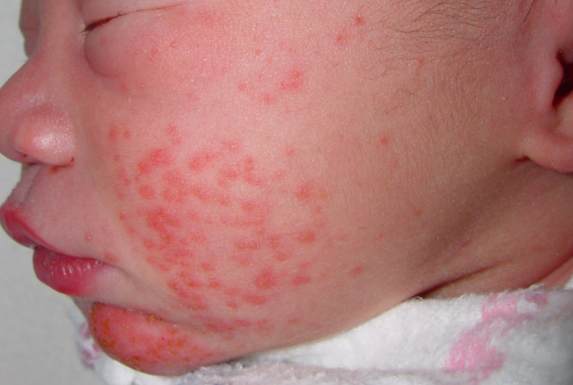Acne (acne vulgaris) is a chronic inflammatory skin condition characterized by open or closed comedones and inflammatory skin lesions such as papules, pustules, or nodules. ICD-10 code: L70, L73.0
Acne is a multifactorial dermatosis, with a pathogenesis largely influenced by genetically determined hyperandrogenism and a genetically determined type of sebaceous gland secretion.
There are four main components in the pathogenesis of acne:
- Increased production of skin sebum.
- Excessive follicular hyperkeratosis.
- Proliferation of cutibacterium acnes (C. acnes).
- Inflammation.
Inflammation is primary in acne and precedes follicular hyperkeratosis, while C. acnes is actively involved in microcomedone formation. Acne is one of the most common skin diseases. According to J. Leyden, acne affects 85% of people between the ages of 12 and 24, 8% of people between the ages of 25 and 34, and 3% of people between the ages of 35 and 44. In adolescence, boys and girls are affected by acne in almost equal proportions, while the prevalence of later-onset acne is significantly higher in females than in males.
Classification:
- L70.0 Acne vulgaris
- L70.1 Acne conglobata
- L70.2 Acne varioliformis
- L70.3 Acne tropica
- L70.4 Infantile acne
- L70.5 Acné excoriée
- L70.8 Other acne
- L70.9 Acne, unspecified
- L73.0 Acne keloid
The following types of acne are distinguished based on the clinical presentation of the disease:
- Comedonal acne.
- Mild to moderate papulopustular acne.
- Severe papulopustular acne and moderate nodular acne.
- Severe nodular acne and Acne conglobata.
Acne is primarily localized on the face, upper extremities, upper chest, and back and manifests as papules, pustules, nodules, and open and closed comedones.
Comedonal acne
Papulopustular Acne
Nodular Acne
Neonatal acne
Infantile acne
Mid-childhood acne
Rare, occurring between the ages of 1 and 6 years. Eruptions are predominantly on the facial skin and consist of comedones and inflammatory acne. It is associated with the risk of concomitant hyperandrogenic conditions (congenital adrenal hyperplasia, androgen-producing tumors).
Pre-adolescent acne
Develops between the ages of 7 and 12, affecting approximately 70% of children, and is the first sign of early puberty. Eruptions are typically localized on the facial skin (T-zone) and consist primarily of inflammatory acne and comedones, with the latter predominant. Open comedones around the earlobes may be the first manifestation. Scarring can occur not only from inflammatory elements but also as a result of comedonal acne.
Adult and Adolescent Acne Characteristics
The clinical presentation of acne in adults and adolescents has its own characteristics in terms of the distribution of affected areas on the lower and upper parts of the face. Adults typically have U-zone involvement (cheeks, around the mouth, and under the chin), while adolescents have T-zone involvement (forehead, nose, and upper part of the chin). In addition, adults may lack papules and pustules. Comedones are always present in adolescent acne, but may be absent in adults. Inflammation tends to be more pronounced in adults.
Subtypes of Acne in Women
- Persistent acne: Occurs in about 80% of women and is characterized by the onset of the condition during adolescence with a gradual transition into adulthood.
- Late-onset acne: First appears in women after the age of 25.
- Recurrent acne: Develops in women who have a history of adolescent acne that has resolved for several years.
In most cases, the diagnosis of acne does not require laboratory testing. Tests should only be performed in the following cases:
Microbiologic test
This is done when there is a suspicion of gram-negative folliculitis, which occurs with prolonged treatment of acne with tetracycline, doxycycline, and minocycline. Samples are collected from pustular discharge and nasal mucosa. A positive result indicates the growth of Enterobacteriaceae, Proteus and Pseudomonas species.
Endocrinological Tests
These are conducted when the following symptoms are present:
- The presence of hirsutism (Ferriman-Gallwey score over 17).
- Irregular menstrual cycles.
- Cushingoid features and obesity.
- Age older than 20 years and lack of response to topical acne therapy.
Endocrinological tests help to rule out or confirm:
- Polycystic ovary syndrome.
- Late congenital adrenal hyperplasia.
- Cushing's syndrome.
- Ovarian and adrenal tumors.
Endocrinological tests include the determination of:
- Follicle-stimulating hormone (FSH).
- Luteinizing hormone (LH).
- Dehydroepiandrosterone sulfate (DHEA-S).
- Androstenedione.
- 17-hydroxyprogesterone.
- Total testosterone.
- Dexamethasone suppression test.
Treatment Goals:
- Reduce inflammation.
- Decrease the number of C. acnes bacteria.
- Reduce sebum production.
- Diminish the influence of androgens on sebaceous glands.
Treatment of acne is based on the severity of the condition and includes both systemic and topical therapies. The following criteria are used to determine the severity of the condition: extent, depth of the process, number of lesions, psychosocial impact, and scarring. Acne is classified into mild, moderate and severe, although there is currently no consensus on the method of assessing severity. For mild acne, only topical therapy is prescribed; for moderate acne, topical therapy may be combined with systemic therapy; for severe acne, systemic therapy is the primary approach.
The action of modern topical preparations is based on their influence on the main pathogenetic mechanisms underlying acne: follicular hyperkeratosis, an increase in the number of C. acnes bacteria and inflammation. To reduce antibiotic resistance in C. acnes, the following principles should be followed in the treatment of acne:
- The duration of antibiotic use should not exceed 8 weeks.
- Avoid concurrent use of systemic and topical antibacterial agents without the topical application of products containing benzoyl peroxide.
- Limit the frequency and duration of antibacterial agent use.
- It is not recommended to use systemic and topical antibacterial agents as monotherapy and maintenance therapy for acne.
Systemic Therapy
Antibiotics
- Tetracycline: 1.0 g orally per day with a total treatment duration of no more than 8 weeks. OR
- Doxycycline: 100-200 mg orally per day with a total treatment duration of no more than 8 weeks.
The use of erythromycin is currently limited due to the high number of C. acnes strains that are resistant to it.
Side effects of antibacterial agents are rare; however, the main problem with their prescription is the development of P. acnes resistance. High resistance rates are primarily associated with patients who self-administer antibacterial agents.
Hormonal Agents
Hormone therapy is currently an effective treatment modality and is recommended for women with significant seborrhea, androgenetic alopecia, SAHA syndrome (seborrhea/acne/hirsutism/alopecia), late-onset acne, and ovarian or adrenal hyperandrogenism. Treatment should be used in consultation with an endocrinologist or gynecologist-endocrinologist.
Androgen Receptor Blockers
- Cyproterone acetate in combination with ethinylestradiol as part of an oral contraceptive (recommended for women with mild to moderate acne). OR
- Spironolactone: 50-150 mg per day as monotherapy or as additional therapy alongside topical treatments in cases of treatment resistance. OR
- Drospirenone: 3 mg in combination with ethinylestradiol 30 mcg as part of a monophasic oral contraceptive (recommended for contraception in women with acne). OR
- Drospirenone: 3 mg in combination with ethinylestradiol 20 mcg as part of a low-dose monophasic oral contraceptive (recommended for the treatment of moderate acne). OR
Inhibitors of Androgen Production
Oral contraceptives containing ethinyl estradiol in combination with progestins are indicated for the treatment of mild to moderate acne in women. Oral contraceptives containing drospirenone are effective in the treatment of comedonal and inflammatory acne.
Systemic Retinoids
- Isotretinoin: 0.5 mg per kg of body weight orally, cumulative dose ranging from 120 mg to 150 mg per kg of body weight, treatment duration depends on the severity of the condition and the tolerability of the drug, ranging from 16 to 24 weeks.
Primary indications for prescribing oral isotretinoin include:
- Severe forms of acne (nodular, conglobate acne, or acne with a risk of scarring).
- Acne resistant to other forms of therapy.
- Acne in combination with significant psychosocial distress related to the condition.
- A tendency for acne to heal with scarring.
The drug is a potential teratogen and has side effects (most commonly reported are cheilitis, dry skin, peeling; less frequently, alopecia, conjunctivitis, headaches, arthralgias, and others).
Safety data for isotretinoin:
- A standard 20-week course of isotretinoin treatment for moderate to severe acne is generally well-tolerated and safe.
- Side effects involving the skin and mucous membranes are common, reversible, respond well to topical moisturizing therapy, and do not require discontinuation of the drug.
- Clinically insignificant laboratory abnormalities may be observed that do not require discontinuation of therapy.
- The contraceptive period after treatment is 1 month.
Topical treatment
- Topical retinoids - adapalene, gel, cream 0.1% once daily (at night) applied externally to clean, dry affected skin area, avoiding contact with eyes and lips. Therapeutic effects typically develop after 4-8 weeks of treatment, with sustained improvement seen after 3 months of treatment. The course of treatment may be extended if necessary. In some cases, due to temporary skin irritation, the number of applications may be reduced or treatment may be temporarily discontinued until signs of irritation disappear.
- Azelaic acid, cream 20%, gel 15% applied externally twice daily (morning and evening). Therapeutic effects are typically observed after 4 weeks of treatment, and for best results it is recommended to continue the product for several months.
- Benzoyl Peroxide gel 2.5-5-10% applied externally twice daily (morning and evening). Therapeutic effects are seen after 4 weeks of treatment, with sustained improvement after 3 months of treatment. Benzoyl peroxide is often used in combination with antibacterial agents for both topical and systemic therapy. There is no development of bacterial resistance with the use of benzoyl peroxide, making it a common choice for patients who have previously received antibacterial therapy.
- Antibacterials - clindamycin phosphate gel 1% or clindamycin hydrochloride solution for topical use 1%. A thin layer of gel or solution should be applied twice daily to the affected skin, which should be clean and dry. The course of treatment should not exceed 6-8 weeks and the medication should always be prescribed in combination with topical retinoids or azelaic acid.
Combination topical treatment:
- Adapalene (0.1%) + benzoyl peroxide (2.5%) gel is applied once daily (at night) to clean, dry affected areas, avoiding eyes and lips. Therapeutic effects are typically observed within 1-4 weeks of treatment. The duration of treatment should be determined by a physician based on the clinical course of the disease. Treatment may be continued for several months if necessary.
- Alternatively, adapalene (0.1%) + clindamycin (1%) gel is applied once daily (at night) to the clean, dry affected area, avoiding the eyes and lips. The course of treatment lasts from 2 to 4 weeks. It is recommended to switch to topical retinoid therapy afterwards.
Recommendations for treatment of comedonal acne:
- Moderate level of recommendations - topical retinoids (adapalene).
- Low level of recommendations - benzoyl peroxide; azelaic acid.
- Not recommended: Topical antibacterial agents; Hormonal antiandrogens, systemic antibacterial agents, and/or isotretinoin; Ultraviolet radiation.
- Open recommendations - laser therapy as monotherapy, photodynamic therapy cannot currently be recommended.
Recommendations for treatment of papulopustular acne (mild to moderate severity):
- High level of recommendations: Combination of adapalene and benzoyl peroxide; Combination of clindamycin and benzoyl peroxide.
- Moderate level of recommendations: Azelaic acid; Benzoyl peroxide; Topical retinoids; For widespread lesions, a combination of systemic antibacterial agents and adapalene.
- Low level of recommendations: Monotherapy with blue light; Combination of erythromycin and tretinoin; Combination of isotretinoin and erythromycin; Oral zinc; For widespread lesions, a combination of systemic antibacterial agents with benzoyl peroxide or adapalene.
- Not recommended: Monotherapy with topical antibacterial agents; Ultraviolet radiation; Combination of erythromycin and zinc; Systemic therapy with antiandrogenic agents, antibacterial agents, and/or isotretinoin.
- Open recommendations - no evidence of effectiveness for red light, lasers, or photodynamic therapy.
Recommendations for the treatment of severe papulopustular acne/nodular acne of moderate severity:
- High level of recommendations - monotherapy with isotretinoin.
- Moderate level of recommendations - systemic antibacterial agents with a combination of adapalene + benzoyl peroxide or with azelaic acid.
- Low level of recommendations - antiandrogenic agents in combination with systemic antibacterial agents; systemic antibacterial agents in combination with benzoyl peroxide.
- Not recommended: Topical monotherapy; Monotherapy with systemic antibacterial agents; Monotherapy with antiandrogenic agents; Visible light; Ultraviolet radiation.
- Open recommendations - laser therapy; photodynamic therapy is effective for this form of acne, but standard treatment regimens have not been developed.
Supportive therapy for acne involves the use of appropriate medications in an intermittent regimen to control the appearance of non-inflammatory and inflammatory acne.
After completion of the initial course of treatment and achievement of a clinical response, maintenance therapy is recommended for up to 12 months. The drug of choice for maintenance therapy is adapalene, with azelaic acid as an alternative.
To minimize antibiotic resistance, the use of topical antibacterial agents as part of maintenance therapy is not recommended. If antimicrobial therapy is necessary, the optimal approach is to use a combination of adapalene and benzoyl peroxide.
Female patients planning pregnancy:
- Topical monotherapy with azelaic acid (15% or 20%) or benzoyl peroxide (2.5-5%).
- Combination of erythromycin with zinc and benzoyl peroxide (up to 5%).
- In severe inflammatory forms of acne, a combination of benzoyl peroxide with clindamycin is recommended topically.
- In cases of severe acne during pregnancy, systemic erythromycin or clindamycin may be used after a thorough assessment of the risk-benefit ratio.
Pregnancy and lactation:
Controlled studies in pregnant women have not been performed. However, in two decades of clinical experience with topical application of azelaic acid (15% and 20%), no side effects of the drug have been observed. In cases of severe acne or in patients resistant to topical therapy after the first trimester of pregnancy, systemic glucocorticoids or antibacterial agents (such as erythromycin or clindamycin) may be used.
Gentle skin care is recommended for newborns with acne, and it is advisable to avoid skin contact with oils. In severe cases, 2.5% benzoyl peroxide is indicated.
For treatment of acne in children and preadolescents, the following medications are recommended as first-line treatments:
- For mild acne (comedomes and/or a small number of papules/pustules): topical retinoids (adapalene), benzoyl peroxide, adapalene + benzoyl peroxide, or a combination of adapalene + benzoyl peroxide + topical antibacterial agent.
- For moderate acne: adapalene + benzoyl peroxide, or a combination of adapalene + benzoyl peroxide + topical antibacterial agent.
- For severe acne: adapalene + benzoyl peroxide + systemic antibiotic.
If there is no adequate response to the treatment being administered, the following medications are recommended:
- For mild acne: Add benzoyl peroxide or a topical retinoid (adapalene) if they are not already part of the combination therapy. Adjust the concentration or formulation of the topical retinoid or change the topical combination therapy.
- For moderate acne: Adjust the concentration or formulation of the topical retinoid, change the topical combination therapy, add a systemic antibacterial agent, isotretinoin, or oral contraceptives (for girls).
- For severe acne: Change systemic antibiotic, use isotretinoin, or prescribe oral contraceptives (for girls).
Optimal treatment outcome can be considered as clinical cure (regression of > 90% of manifestations from the initial level) or clinical remission (regression of clinical manifestations by 75-90%).
Procedure in case of treatment ineffectiveness:
If there is no response to antibacterial therapy in combination with adapalene, the combination of adapalene with benzoyl peroxide or azelaic acid in cases of moderate papulopustular/acne of moderate severity, systemic isotretinoin therapy is recommended.







